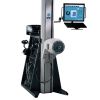
Finding the Best Competitive Advantage for Your Clinic – It’s All About Return on Investment
Practice ManagementGone are the days of just going to the clinic that’s closest to home. Consumers of healthcare are becoming more active buyers, just like consumers in general. They do their research before they pick a provider, and that research most often starts online.
As we enter 2019, ask yourself – what steps are you taking to differentiate your clinic from the competition? If your clinic looks like every other rehab clinic, why would a potential client choose yours? Why would case managers, physicians, past clients or employers steer a new referral to your clinic?
Gone are the days of just going to the clinic that’s closest to home. Consumers of healthcare are becoming more active buyers, just like consumers in general. They do their research before they pick a provider, and that research most often starts online.
So take a moment to place yourself in your client’s shoes. Do a little of your own research, and see how the competition in your area presents itself. Odds are, besides the name on the website and the faces of the staff, you won’t see much difference from one clinic to the next. What does your website say about your competitive advantage? Your clinic has to stand out.
So now you’ve done your Google search of local clinics. You realize that your clinic doesn’t stand out, and that’s a problem. Is there a way to stand out and boost clinic revenues as well? Are you ready to make an investment in your clinic’s future? (Not sure? Click here to figure out if it’s time to grow your clinic).
Spend money to make money
As the saying goes, you have to spend money to make money. The same goes for clinic revenue. Investing in your clinic is the best way to grow revenue. Like all investments, predicting the outcome involves a little guesswork. There is a predictable risk involved. But with a good plan, you can minimize the guesswork, and project an accurate return on investment (ROI) for your clinic.
As you make your 2019 financial plan, consider what will help draw new clients to your clinic. For additional clients, or even for your current clients, why are they going to continue paying today’s high copays through their full course of recommended treatment? Personalized care is important, but so is offering some unique treatments that clients can’t get from their home exercise routine.
Choose your investment
Step one in making a plan is figuring out what type of investment is right for your clinic. Is it adding staff, developing a specialty service, adding new equipment, improving your website? The right plan probably involves a combination of the above, since one change can lead to another.
Share your vision
Once you’ve decided on one or a few areas of improvement, how do you convince management (or your partners) to buy into the idea? You need to paint the picture for them, and show how your idea can make a positive impact on the clinic. They will likely agree with the desire to improve the clinic, but the key is to show why adding this new service or that piece of equipment is the best way to do that.
What’s the best way to show the value an investment can add to your clinic? With an ROI calculation. Here’s how to calculate ROI for your clinic…
Start with what you know
The best ROI tool is interactive. It will show you how your ROI is affected when you change certain variables. To do this, start with a spreadsheet like Excel.
Make a list of all the known factors, starting with current revenue and investment cost. When looking at current revenue, make sure to get the numbers on reimbursement per patient visit that is actually collected, not what is charged.
Getting an accurate number on investment cost sometimes takes some digging. For example, if you’re going to hire a new clinician, the direct cost is that person’s salary. But you should also consider your hours spent recruiting, interviewing, and training this person, as well as their health insurance, time off, and any educational benefits you may offer.
If you want to invest in new equipment, you’ll want to know the cost of the equipment itself, along with warranty, time training employees, and financing options. Remember, it’s standard accounting practice to spread capital equipment costs over a few years – it might not pay for itself in one year alone. So, consider tax incentives such as the 179 Tax Credit for investment in new equipment – the federal government helps cover some of your costs with this credit.
If you want to add a new specialty service, like burn rehab, you’ll need both qualified employees and the right equipment.
Closer look at CPT reimbursement codes
As discussed in an earlier post, most states pay higher for the 97530 code for therapeutic activity than the 97110 therapeutic exercise. Adding new services or equipment can help you take advantage of higher-billed codes. Click here to see how you can take advantage of increased reimbursement codes!
For example, most clinics don’t utilize the 97750 CPT code, for physical performance test with written report, very much. If you add equipment that produces objective data for strength or functional testing, this further adds to your return. Testing that is billed under this code is usually two or more units per test, and can be billed once per month in most states as a means to document improvement and outcomes.
It’s OK to make assumptions
Next, make a list of assumptions that you expect to get out of your investment. Realize that it’s safer to project numbers conservatively.
If you’re adding a new service, how many more patients do you expect per week? If adding new equipment (especially modalities that allow higher reimbursement), how many higher-billed hours do you expect per week? Create different columns for income per week, month, and year.
If adding new services helps gain even one new referral per month from a current referral source, each referral adds up nicely when you multiply the expected number of visits per month per patient.
Think about clinic process improvements. If you add services that current patients can’t do in their home exercise routine, consider the value of better patient retention and how much revenue is generated from just one additional visit.
The national average for patient drop-out from those who stop coming due to high copays is after 3-4 visits. If you can retain those who drop out quickly for only one more visit, that’s more new revenue potential for your clinic. And we know that patients either don’t do their home exercise or don’t do it properly, so their best path to recovery is through your clinic.
Putting it all together
Your spreadsheet will now show how the total annual costs, when subtracted from the new, additional revenue, still yield a healthy profit. Remember to project conservatively, and you will have room to surpass your expectations. Also keep in mind that some investments take time to make a positive return.
If you are not happy with the time it takes to realize a high ROI on your growth plan, take a look at what variable could have the biggest impact on that. Do you need to get more patients into a service, or can you change the procedure to qualify for a higher-billed CPT code?
With all your variables identified, you can then make adjustments to the projections. Changing any number will be immediately reflected in your totals if you set the spreadsheet to add all revenues and all costs, and then subtract one from the other. It’s a good way to play “what if?”.
As you plan for continued growth and success in 2019, remember: investment is key to growing your clinic. Investing in your clinic can improve your competitive advantage against other clinics, enhance the quality of care for your patients, and make your clinic a better place to work and grow. And the best tool to help guide your decision-making is your ROI calculation spreadsheet. It’s a powerful tool that can make what seems like a daunting number of variables become quite manageable, helping you make the best investments that truly pay off for you and your clinic.
John Vermette, MBA
Director of Provider and Product Management
BTE





